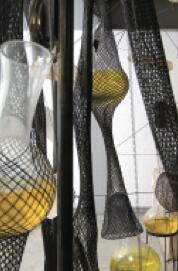TUNGA
Millan, Sao Paulo
Between September and October of the past year, the famous Brazilian artist Tung (Palmares, 1952) made a strong impression on the visitors to the Moscow Biennial. Supported by metal structures, laboratory flasks containing a yellowish liquid resembling urine were tied to phallic-shaped crystal fragments and simulacra of faeces. The installation “Cooking Crystals” has now been recreated at Millan Gallery under the title of “Cooking Crystals Expanded”. Alongside this installation, Tunga is featuring a new series of autonomous works, the “Cristalinos”, composed of two portals, a floor sculpture and twelve wall sculptures. The materials employed are those that are recurring in the artist’s work: magnets, steel, glass bottles, besides the emblematic rock crystals, romantic material par excellence, which on this occasion have been heated in an oven at extremely high temperatures (hence the term “Cooking” contained in the title).

Formally trained as an architect, Tunga has always declared himself to be a reader of texts on alchemy. In his opinion, this ancient encounter between science and magic is what also originates the fundamental art processes. As an artist- alchemist, he succeeds in transforming the spectator into the agent of a visceral experience, forcing him/her to cross the midpoint between the scientific and the poetic discourse. Undoubtedly, the most direct reference is the one that concerns Antonin Artaud. Man has his geography, a territory which must be explored, investigated, mutilated to feed the sadistic desire of science and medicine. Tunga reminds us of the fact that we are born amidst faeces and urine, but society hides these excrements because they are not “civilized”. There is also something profoundly Foucauldian in this sort of archaeology of the visceral. According to the artist himself, the installation may be perceived as “a logical constellation, a metabolical zone, a magnetic field, a crystallographic structure, a connective cloud, or an escatological nebula.”
As art critic Carlos Basualdo has remarked, since 1989 the artist has sought to “redefine sculpture not only as a static volume, but also as the grouping of expanding forms and the relation- ship between them.” In this respect, “Cooking Crystals” follows the same lines that the works that the artist exhibited at the Documenta fair (1997) and, more recently, at the Louvre. (In 2005, the French museum hosted the installation “At the Light of Both Worlds”, inspired by the paintings of Frans Post. Consisting of skulls, metal skeletons, fabric and mesh, the installation made reference to the painter’s difficulties when he arrived in South America and was confronted with a luminosity which was completely different from the European one).
The exhibition at Millan Gallery also includes “Cookery”, a video that has recently been selected to participate in an international exhibition of pornographic films made by artists. In the sequence, a couple on their honeymoon engages in an escatologic orgy in which each partner drinks the other’s urine. In a fit of lust, the woman performs fellatio on a large piece of crystal that is magically transformed into a piece of ice that melts in her mouth. Side by side, installation, sculptures and film are dis- played as part of an intricate game of carnal exploration. As the viewer tours the exhibit, the erotic or scatological, depending on the point of view totality of the human nature emerges.





